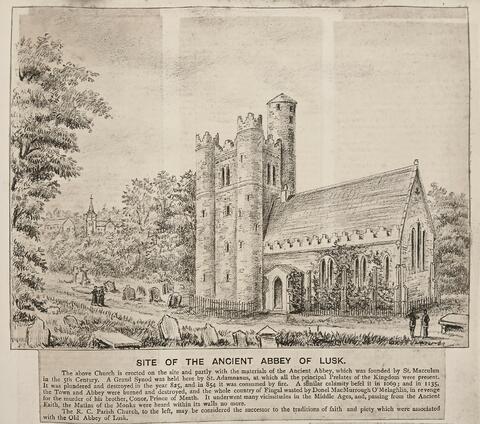Reference code
Title
Date(s)
- c.1890 (Creation)
Level of description
Extent and medium
1 p.; clipping
Name of creator
Repository
Archival history
Immediate source of acquisition or transfer
Scope and content
A clipping of an illustration of Saint MacCullin’s Anglican church in the town of Lusk in North County Dublin. The caption refers to the building as the ‘site of the ancient Abbey of Lusk’, a reference to the monastery founded at this location by Saint MacCullin (or Macculun) in the late fifth century. The round tower attached to the church dates to about the tenth century and is the only surviving remnant of the early medieval abbey. The round tower was later incorporated into the design of a fortified tower house built in the fifteenth century. This defensive tower house had three more round towers added to each corner to give the building extra strength and balance. It houses several sixteenth-century tombs including that of James Bermingham (1527) and an elaborate effigy tomb of Sir Christopher Barnwall and his wife, Marion Sharl (1589).
An Anglican church (Saint MacCullin’s Church of Ireland) was constructed in an Early English Gothic style on the site in 1847. The pointed reference in the text to the Roman Catholic church in Lusk (also dedicated to Saint MacCullin) as the ‘successor to the traditions of faith and piety’ associated with the medieval abbey represents an attempt to assert the historical continuity of the ‘Ancient Faith’ in opposition to post-Reformation Protestant religious practice. Saint MacCullin’s Anglican church now houses Lusk Heritage Centre which offers guided tours of the historic building to the public.

